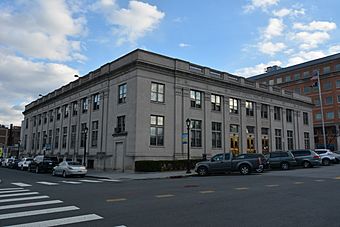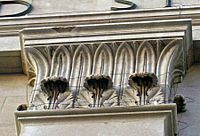United States Post Office (Yonkers, New York) facts for kids
Quick facts for kids |
|
|
U.S. Post Office
|
|

South profile and west elevation, 2014
|
|
| Location | Yonkers, NY |
|---|---|
| Area | less than one acre |
| Built | 1927 |
| Architect | James Wetmore |
| Architectural style | Classical Revival |
| MPS | US Post Offices in New York State, 1858-1943, TR |
| NRHP reference No. | 88002448 |
| Added to NRHP | May 11, 1989 |
The U.S. Post Office in Yonkers, New York, is a special building. It's located right in the heart of downtown Yonkers, across from the city's train station. This two-story building is made of stone and was built in the late 1920s.
Even though it has a specific ZIP Code (10702), this post office helps serve the entire city of Yonkers. In 1989, it was added to the National Register of Historic Places. This means it's an important historical site, just like many other old post offices in New York State.
The location for this post office was chosen by Secretary of the Treasury William Gibbs McAdoo. The building was designed by the Treasury Department's Office of the Supervising Architect, led by James A. Wetmore. Since Yonkers was a growing city, this post office was built larger than most others at the time. Its design mixes old-style Classical Revival with hints of the newer Art Deco look. Today, it still looks much like it did when it was first built.
Contents
The Yonkers Post Office Building
The post office building takes up a whole city block. It's bordered by Main Street, Buena Vista Avenue, Nepperhan Street, and Market Place. The ground around it is flat because the Hudson River is very close by. You can see the river just past the train tracks. The old train station building, built in 1911, is also nearby.
Across the square from the post office is the city's new library. This library is in buildings that used to belong to the Otis Elevator Company. The area around the post office is busy, with many older commercial buildings. A famous historical site, Philipse Manor Hall State Historic Site, is also just a block away.
Outside the Building
There's a flagpole at one corner of the block. Small hedges surround most of the building. The post office itself is made with a strong steel frame and covered with smooth, light-colored limestone. It has a flat roof. The building is mostly square, except for the back (east side).
Most sides of the building look similar. They have flat, decorative columns called pilasters that divide the windows. These pilasters support a decorative band called an entablature near the roof. The roofline also has a fancy edge called a cornice and a low wall with railings, known as a balustrade.
On the first floor, the windows are tall with two parts that slide up and down. They also have a small window above them called a transom. The second-floor windows are similar but don't have the transoms.
The main entrances are on the west and south sides. They have steps leading up to them and original bronze lampposts. Each entrance has large bronze double doors. Above the doors are decorative carvings. There are also smaller entrances on the north and east sides. The north entrance is no longer used.
On the east side, there's a large covered area for loading and unloading mail. This area has garage doors where trucks can drive in. The second story above this area has windows like the rest of the building.
Inside the Building
When you enter, you walk through bronze vestibules into an L-shaped lobby. The lobby floor is made of terrazzo, a type of mosaic flooring, and the walls have buff-colored marble up to a certain height. Flat marble pilasters (decorative columns) go up to the ceiling. The ceiling is decorated with square patterns called coffers. Many surfaces inside have detailed carvings.
Along the outer wall, you'll find oak bulletin boards framed by marble. The oak tables where customers can write are also original. An L-shaped staircase with marble steps and a brass railing leads to the second floor. On the inner wall, there are mailboxes and teller windows where postal workers help customers. Behind these areas is the main workroom. The second floor has offices, and the basement holds mechanical rooms and storage.
History of the Post Office
Early Mail Delivery in Yonkers
Yonkers started getting regular mail after the Albany Post Road was finished, soon after the American Revolution. At first, mail went to Philipse Manor. In 1788, mail began going to Old Hunt's Tavern. Then, in 1797, Yonkers got its first official post office. It was in the country store of Alpheus Pierson, Yonkers' first postmaster. In 1863, mail started being delivered directly to homes for free.
Yonkers grew very quickly in the late 1800s. This was due to new factories and the Hudson River Railroad, which opened in 1849. Many textile mills opened, along with companies like the Otis Elevator Company. Yonkers officially became a city in 1872.
Postmasters and Politics
The job of postmaster became very political. It was often given to people who helped local politicians stay in power. This was especially true in Yonkers because so much mail went through the city. Politicians would even hold secret meetings in the postmaster's office.
Sometimes, this meant that the postmasters weren't very good at their jobs. In 1905, a very bad postmaster and his helper were fired because people were so angry about the poor mail service. President Theodore Roosevelt then appointed John Parsons to the job temporarily. Local politicians complained, but Roosevelt didn't listen.
Parsons took his job seriously and quickly made mail service much better. Roosevelt later gave him a full four-year term. But when his term ended in 1909, Roosevelt was no longer president. Even though Parsons was good at his job, local politicians didn't want him reappointed. They gave the job to someone else instead.
Building the New Post Office
As the 1900s continued, Yonkers kept growing. Many wealthy people from New York City moved there for bigger homes and a quieter life. They could still take the train to their jobs in the city. Because of this growth, a new, larger post office was needed.
In 1906, Congress passed the first law to allow the new building. But it took a long time to buy the land. By 1919, the government had spent a lot of money buying the land and the buildings on it. This included the old post office, a hotel, a store, and even a junkyard.
Treasury Secretary William Gibbs McAdoo, who used to live in Yonkers, personally chose the location for the new post office. He liked that it was close to both the train and the city's trolley lines. Construction finally began after Congress approved it again in 1926. The budget was increased, and the building was finished in 1927.
The Completed Post Office
The Yonkers post office was much bigger than most others built in New York around that time. Most were smaller brick buildings. But Yonkers needed a large post office because of its growing population. Like other big city post offices, it was built in the Classical Revival style.
James A. Wetmore, the Supervising Architect for the Treasury Department, is given credit for the design. He oversaw many federal buildings during his 18 years in the role. However, he was a lawyer, not an architect. The actual architectural design work was usually done by Louis A. Simon, who later became the Superintendent of Architects.
The Yonkers post office looks very grand and solid. Its design uses simple shapes and smooth surfaces. These features were common in Classical Revival buildings of that time. They showed the importance of a government building while also being cost-effective. These designs also hinted at the Art Deco style that would become popular later.
The building has had only a few small changes since 1927. The loading dock area has been updated. The north entrance on Nepperhan Street was closed to make space for an office. Inside the lobby, some teller windows have been changed, and the lights are new. But most of the furniture and original finishes are still there.





